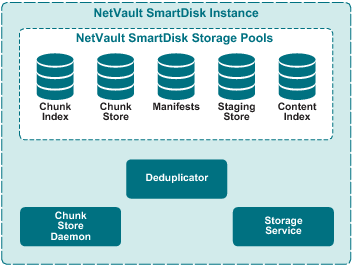Downloading the software
Evaluation versions of vRanger and NetVault SmartDisk are available from the vRanger page on the Quest website. Evaluation versions are full applications limited only by licensing.
|
2 |
Click Download Free Trial. |
|
5 |
Select vRanger, and save the file to the desired location. |
|
2 |
Click Download Free Trial. |
|
5 |
Select NetVault SmartDisk, and save the file to the desired location. |
Understanding NetVault SmartDisk
The basic components of a NetVault SmartDisk Instance are shown in the following image, and described in the topics that follow.
Figure 1. Components

Components
A NetVault SmartDisk Instance includes one or more Storage Pools and a set of processes that perform byte-level, variable-block software deduplication. You can deploy a single NetVault SmartDisk Instance on a dedicated server, or a different server or client, and it can accept data streams from heterogeneous platforms. In addition, you can deploy multiple NetVault SmartDisk Instances to distribute network, disk, and deduplication resources, which improves load balancing and performance. When multiple NetVault SmartDisk Instances are deployed, Storage Pools and processes are not shared across the multiple NetVault SmartDisk Instances. Data written to a NetVault SmartDisk Instance is deduplicated globally, regardless of the data’s source. For example, if you have two vRanger instances writing to the same NetVault SmartDisk Instance, the data is treated as if it came from a single source.
NetVault SmartDisk Storage Pools
 |
 |
A NetVault SmartDisk Storage Pool includes one or more file-system volumes, which you can easily extend by adding additional file-system paths. Each Storage Pool is associated with roles that it can perform. When configuring the Storage Pool, you can specify the preferred roles or the roles not allowed. Available roles include the Content Index (also called Disk Index), Staging Store (also called Staging), Chunk Index, and Chunk Store (also called Storage). For example, Storage Pool A is used for the Content Index and the Chunk Index while Storage Pool B is only used for the Staging Store and Chunk Store. Storage Pool A can include fault-tolerant disks with good random-access performance, while Storage Pool B includes fault-tolerant disks with good streaming performance. When NetVault SmartDisk is analyzing the available Storage Pools, it chooses the optimal Storage Pool to use based on available space, the defined roles, and other current activity in the NetVault SmartDisk Instance.
|
• |
Content Index: The NetVault SmartDisk Content Index role is the index where the NetVault SmartDisk Instance tracks the data it is protecting and whether it is stored in the Staging Store or the Chunk Store. The Content Index is relatively small and should reside in a Storage Pool made of fault-tolerant disks with good random-access performance. |
|
• |
Staging Store: The NetVault SmartDisk Staging Store role is where all nondeduplicated data streams are stored, whether they are awaiting post-processing deduplication or were not selected for deduplication. Data streams that were selected for deduplication are deleted from the Staging Store after the post-processing deduplication is completed. The Staging Store should reside in a Storage Pool made of fault-tolerant disks with good streaming performance. |
|
• |
Chunk Index: The NetVault SmartDisk Chunk Index role is a list of the unique Chunks and where each Chunk is stored in the Chunk Store. There is one Chunk Index per NetVault SmartDisk Instance. The Chunk Index should reside in a Storage Pool made of fault-tolerant disks with good random-access performance. |
|
• |
Chunk Store: The NetVault SmartDisk Chunk Store role is where the unique Chunks are stored. The Chunk Store should reside in a Storage Pool made of fault-tolerant disks. |









